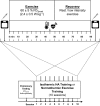Hsp72 and Hsp90α mRNA transcription is characterised by large, sustained changes in core temperature during heat acclimation
- PMID: 27511024
- PMCID: PMC5083671
- DOI: 10.1007/s12192-016-0726-0
Hsp72 and Hsp90α mRNA transcription is characterised by large, sustained changes in core temperature during heat acclimation
Abstract
Increased intracellular heat shock protein-72 (Hsp72) and heat shock protein-90α (Hsp90α) have been implicated as important components of acquired thermotolerance, providing cytoprotection during stress. This experiment determined the physiological responses characterising increases in Hsp72 and Hsp90α mRNA on the first and tenth day of 90-min heat acclimation (in 40.2 °C, 41.0 % relative humidity (RH)) or equivalent normothermic training (in 20 °C, 29 % RH). Pearson's product-moment correlation and stepwise multiple regression were performed to determine relationships between physiological [e.g. (Trec, sweat rate (SR) and heart rate (HR)] and training variables (exercise duration, exercise intensity, work done), and the leukocyte Hsp72 and Hsp90α mRNA responses via reverse transcription quantitative polymerase chain reaction (RT-QPCR) (n = 15). Significant (p < 0.05) correlations existed between increased Hsp72 and Hsp90α mRNA (r = 0.879). Increased core temperature was the most important criteria for gene transcription with ΔTrec (r = 0.714), SR (r = 0.709), Trecfinal45 (r = 0.682), area under the curve where Trec ≥ 38.5 °C (AUC38.5 °C; r = 0.678), peak Trec (r = 0.661), duration Trec ≥ 38.5 °C (r = 0.650) and ΔHR (r = 0.511) each demonstrating a significant (p < 0.05) correlation with the increase in Hsp72 mRNA. The Trec AUC38.5 °C (r = 0.729), ΔTrec (r = 0.691), peak Trec (r = 0.680), Trecfinal45 (r = 0.678), SR (r = 0.660), duration Trec ≥ 38.5 °C (r = 0.629), the rate of change in Trec (r = 0.600) and ΔHR (r = 0.531) were the strongest correlate with the increase in Hsp90α mRNA. Multiple regression improved the model for Hsp90α mRNA only, when Trec AUC38.5 °C and SR were combined. Training variables showed insignificant (p > 0.05) weak (r < 0.300) relationships with Hsp72 and Hsp90α mRNA. Hsp72 and Hsp90α mRNA correlates were comparable on the first and tenth day. When transcription of the related Hsp72 and Hsp90α mRNA is important, protocols should rapidly induce large, prolonged changes in core temperature.
Keywords: Core temperature; Heat acclimation; Heat shock proteins; Hyperthermia; Thermotolerance.
Conflict of interest statement
Compliance with ethical standards All protocols, procedures and methods were approved by the institutional ethics committee. Participants completed medical questionnaires and written informed consent following the principles outlined by the Declaration of Helsinki as revised in 2013 prior to commencing any preliminary or experimental sessions.
Figures





Similar articles
-
Heat acclimation attenuates physiological strain and the HSP72, but not HSP90α, mRNA response to acute normobaric hypoxia.J Appl Physiol (1985). 2015 Oct 15;119(8):889-99. doi: 10.1152/japplphysiol.00332.2015. Epub 2015 Jul 23. J Appl Physiol (1985). 2015. PMID: 26205540
-
Isothermic and fixed-intensity heat acclimation methods elicit equal increases in Hsp72 mRNA.Scand J Med Sci Sports. 2015 Jun;25 Suppl 1:259-68. doi: 10.1111/sms.12430. Scand J Med Sci Sports. 2015. PMID: 25943677
-
Downhill running and exercise in hot environments increase leukocyte Hsp72 (HSPA1A) and Hsp90α (HSPC1) gene transcripts.J Appl Physiol (1985). 2015 Apr 15;118(8):996-1005. doi: 10.1152/japplphysiol.00387.2014. Epub 2015 Feb 26. J Appl Physiol (1985). 2015. PMID: 25722377
-
Insights into the role of heat shock protein 72 to whole-body heat acclimation in humans.Temperature (Austin). 2015 Nov 11;2(4):499-505. doi: 10.1080/23328940.2015.1110655. eCollection 2015 Oct-Dec. Temperature (Austin). 2015. PMID: 27227070 Free PMC article. Review.
-
Hsp90α and cell death in cancers: a review.Discov Oncol. 2024 May 10;15(1):151. doi: 10.1007/s12672-024-01021-0. Discov Oncol. 2024. PMID: 38727789 Free PMC article. Review.
Cited by
-
Heat Acclimation-Mediated Cross-Tolerance: Origins in within-Life Epigenetics?Front Physiol. 2017 Jul 28;8:548. doi: 10.3389/fphys.2017.00548. eCollection 2017. Front Physiol. 2017. PMID: 28804462 Free PMC article. Review.
-
Brain-derived neurotrophic factor in older adults exposed to simulated indoor overheating.Eur J Appl Physiol. 2025 Mar;125(3):769-780. doi: 10.1007/s00421-024-05623-y. Epub 2024 Oct 17. Eur J Appl Physiol. 2025. PMID: 39417862
-
Hypoxic Air Inhalation and Ischemia Interventions Both Elicit Preconditioning Which Attenuate Subsequent Cellular Stress In vivo Following Blood Flow Occlusion and Reperfusion.Front Physiol. 2017 Aug 2;8:560. doi: 10.3389/fphys.2017.00560. eCollection 2017. Front Physiol. 2017. PMID: 28824456 Free PMC article.
-
The mechanisms behind heatstroke-induced intestinal damage.Cell Death Discov. 2024 Oct 28;10(1):455. doi: 10.1038/s41420-024-02210-0. Cell Death Discov. 2024. PMID: 39468029 Free PMC article. Review.
-
Could Heat Therapy Be an Effective Treatment for Alzheimer's and Parkinson's Diseases? A Narrative Review.Front Physiol. 2020 Jan 10;10:1556. doi: 10.3389/fphys.2019.01556. eCollection 2019. Front Physiol. 2020. PMID: 31998141 Free PMC article. Review.
References
MeSH terms
Substances
LinkOut - more resources
Full Text Sources
Other Literature Sources
Medical
Research Materials

